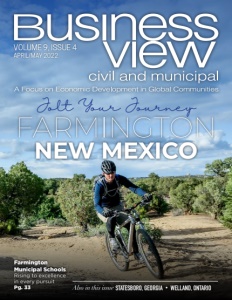Welland, Ontario
A New Day Has Come
Business View Magazine interviews representatives of Welland, Ontario for our focus on Economic Development in Canadian Cities
Once known as the place where ‘rails and water meet’ – a hub for industrial manufacturing halfway between Toronto and Buffalo – Welland, Ontario, is now forging its own path. The growing Niagara region city has seen exponential growth over the past five years, allowing it to remediate and redevelop former industrial brownfields to make room for new technology, new housing, and plenty of recreational opportunities. “I think we are quite proud of us being a great place to live, work, play, and invest,” says Welland CAO Steve Zorbas.

CAO, Steve Zorbas
Founded by United Empire Loyalists in 1788, the city’s proximity and location along the Welland River and just 15 miles from Niagara Falls, made it an ideal spot for industrial manufacturing, including steel, automotive and textiles. With changes to the economy in recent years causing the closure or relocation of many of these plants, the city ended up with around 500 acres of brownfield land that was left empty and contaminated. Rather than let the city fall into decline, Welland’s City Council has stepped up to find ways to change those brownfields into lands of opportunity.
“We have seen significant brownfield redevelopment in the city,” Zorbas says. “We’ve offered a tax increment grant and other incentives to facilitate and encourage developers to consider redeveloping brownfields, and it’s working for us. We are excited about it, and it’s looking fantastic as well.”
Many developers are taking advantage of the incentives, which is completely changing the city’s landscape. The former John Deere industrial site and adjacent lands along the Welland Shipping Canal will soon become a residential development by Empire Homes, which will include approximately 2,190 new dwelling units including single detached, semi-detached and townhouse dwellings and mixed-use commercial and residential buildings. Plaza Comm has turned a former coal yard into the site of a new commercial standalone McDonald’s, and a six-storey retirement residence that will connect to the adjacent city-run community centre.
The city itself purchased an 8-acre brownfield site five years ago which was a portion of the former Atlas Steel lands and is just putting the finishing touches on a new fire station in its place. “It will be a significant redevelopment of that brownfield site,” Zorbas says. “We had it cleaned up and there will be a fire training tower for our firefighters. It will be a major attraction for other firefighters in the region to take training if they desire. It’s one-stop shopping for fire departments.”
Though Welland has bid adieu to many of its traditional manufacturing companies, that doesn’t mean they’ve been left out in the cold when it comes to new business. Over the past seven years, there has been tremendous growth with new industry and businesses locating in the city. “There’s been a significant economic resurgence in terms of new job opportunities,” Zorbas explains. “One of the biggest catalysts is the INNIO plant (the former GE plant), which decided to relocate from Waukesha, Wisconsin to Welland. That was the catalyst, and there have been a host of other businesses and industries that have since opened up or are about to open up.”

Planning Director, Grant Munday
GE broke ground on the $240 million, 500,000 square foot “brilliant factory” in 2016, and sold it to Advent International in 2018. Advent is using the facility for its standalone energy company INNIO to produce Waukesha fuel flexible gas engines. The “brilliant” factory is the first of its kind in Canada and is the brainchild of GE. The facility uses machines embedded with sensors that can transmit information to remote engineers via industrial internet. “There’s all kinds of automation in the plant using robots,” says Grant Munday, Welland’s Planning Director. “They employ over 250 people now and the parking lot is full. It’s actually one of our best design projects for industrial in the city. It has permeable paving and car charging stations and all of its landscaping is comprised of drought-tolerant, native species.”
With GE came a resurgence of new business into the area. Over the past two years, Welland completed its seventh industrial park, which is already at 80 percent capacity. The parks are home to businesses from big to small, including Northern Gold Foods, that operates an industrial bakery out of a 200,000 square-foot facility. As well as Devron Sales Ltd. that produces and sells wide range of products that are related to the construction, drainage and environmental industries.
Unlike its traditional manufacturing industries of the past, Welland is becoming a place where new technology can thrive. Along with the INNIO brilliant factory, the city is also home to Intravision Greens.
“It’s a space-age technology where they grow leafy greens in totally controlled environments with LED lights,” Munday says. “Hands barely ever touch the product. It goes through an automated system that works on tracks and basically in two weeks’ time they can have a full head of lettuce from seed to finish.
They are planning to actually expand further with their facility. They started with phase one and they’ve had great success.”
The city was successful in landing its new breed of industry thanks to its forward-thinking economic development department. “They are leading edge,” Zorbas says. “They planted the seeds years ago and I would say they have very progressive and out-of-the-box thinking. The city is unique here – not only do we purchase industrial land, we service it, and we sell industrial land to the private sector to come to Welland.”
With all the growth in new business has come a growth in population and housing. The city’s population grew from 52,293 in 2016 to 55,750 in 2021 and is set to take off in the next 20 years, predicted to eclipse 80,000 residents. “Companies see this area as a critical growth area for their business,” Munday says. “We have lots of interest and lots of land available for employment development and industrial development and residential growth, as well. If you get more industrial growth, you get more housing.”
The city’s mayor and council recently approved more than 9,000 new housing units for the city. And this is only just the beginning. Welland foresees its growth to continue to rise at an even greater rate than it is already. Munday reports, “The current census and building permit data have shown that we are growing faster that anticipated. The census indicated we added almost 1200 new dwelling units in five years and our 2021 building permit data shows we have 759 new dwelling unit starts, which would not be reflected in the census. With the growth we’ve had from the last census, we can tell by our current permit volumes that we will have even more significant growth in the next five years. In the last two years, we did almost more units than we did the previous five years in total. We know that many of those units are unoccupied, so in the next five years, we will see that population growth we’ve had in the past five years probably doubled.”

In addition to its attractive business landscape, Welland’s natural landscape and recreational opportunities are also a draw to the city. Set along both sides of the Welland River and the Welland Canal, the city has beautiful waterfront views and a trail system that allows residents and visitors to take full advantage.
The Welland Regional Canal includes a large park area with more than 1,000 acres of land, 24 kilometers of trails and 12 kilometers of waterway. The park offers tons of amenities including a community centre, amphitheatre, scuba diving, canoeing, and kayaking, as well as bike and walking trails. “We have a great waterfront community,” Zorbas says. “Our recreational canal provides multi-seasonal opportunities, especially in the summertime. It’s a great body of water for people to swim, canoe, kayak, and probably some of the best pathway systems for biking and pedestrians in the Niagara region.”
The City Council has approved a Community Trails Strategy which is master on and off-road pathway plan that will connect the recreational canal paths to existing and new paths and to destinations like the Seaway Mall, which is being redeveloped to include high and medium density condos, a transit terminal, and trails. “The area will serve as a connecting point to the rest of Niagara, as well as Niagara College,” Zorbas notes. And it doesn’t stop there. Welland is constantly working to continue to improve its recreational offerings for the city’s ever-growing population of residents.
“The exciting thing with this population growth is that we are already working on the amenities that all those people are going to enjoy,” Zorbas says. “It’s not going to be a situation where we have all this growth and we are trying to figure out what are these people going to do for recreation. We are working on the solution at the same time, and before the growth comes, to make sure we have a plan in place and the infrastructure in place.”With all its recent improvements, Welland is taking back the reins and returning the city to the glory it once had in years past. “We are seeing the return of the economic vitality that the city had back in the ‘40s, ‘50s, and ‘60s,” Zorbas shares. “It’s back in a big way for the city.”
*Photos courtesy Anthony Gallaccio
AT A GLANCE
Welland, Ontario
What: A rapidly growing city of 55,000
Where: In the Niagara region of southern Ontario, between Toronto and Buffalo
Website: www.welland.ca





